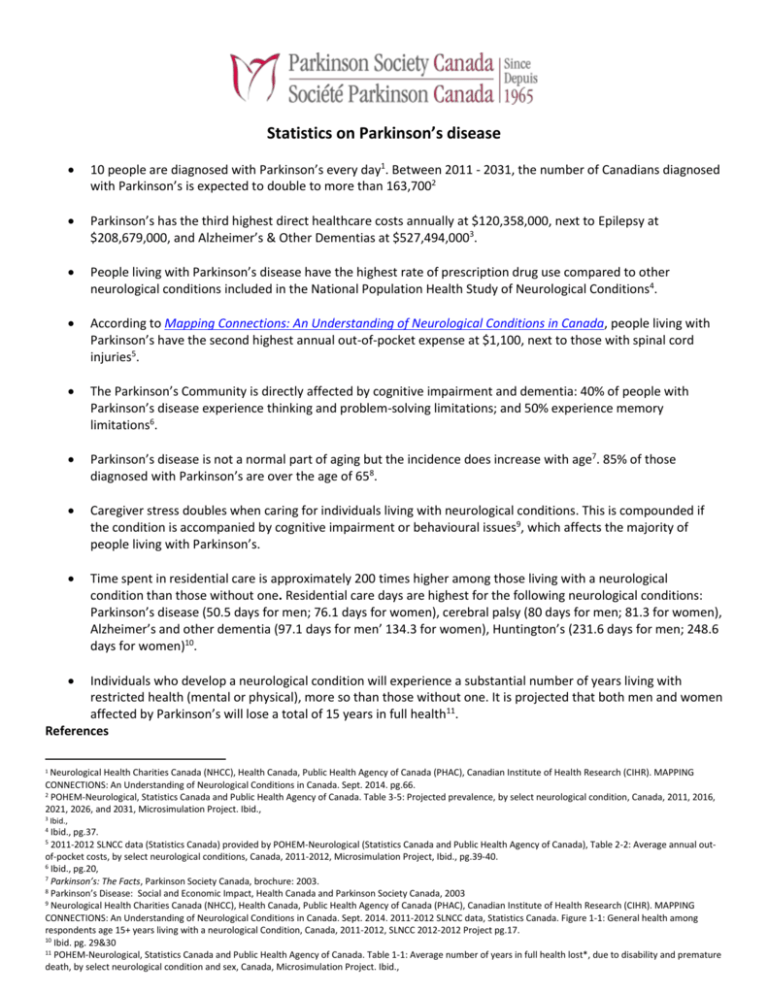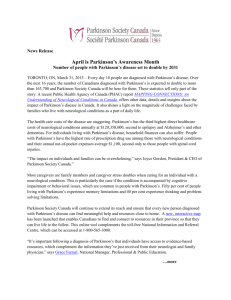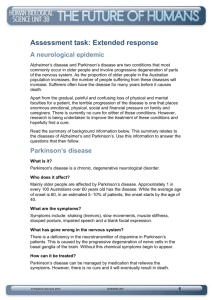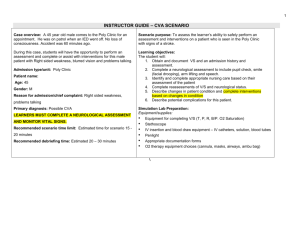Statistics on Parkinson`s disease
advertisement

Statistics on Parkinson’s disease 10 people are diagnosed with Parkinson’s every day1. Between 2011 - 2031, the number of Canadians diagnosed with Parkinson’s is expected to double to more than 163,7002 Parkinson’s has the third highest direct healthcare costs annually at $120,358,000, next to Epilepsy at $208,679,000, and Alzheimer’s & Other Dementias at $527,494,0003. People living with Parkinson’s disease have the highest rate of prescription drug use compared to other neurological conditions included in the National Population Health Study of Neurological Conditions4. According to Mapping Connections: An Understanding of Neurological Conditions in Canada, people living with Parkinson’s have the second highest annual out-of-pocket expense at $1,100, next to those with spinal cord injuries5. The Parkinson’s Community is directly affected by cognitive impairment and dementia: 40% of people with Parkinson’s disease experience thinking and problem-solving limitations; and 50% experience memory limitations6. Parkinson’s disease is not a normal part of aging but the incidence does increase with age7. 85% of those diagnosed with Parkinson’s are over the age of 658. Caregiver stress doubles when caring for individuals living with neurological conditions. This is compounded if the condition is accompanied by cognitive impairment or behavioural issues9, which affects the majority of people living with Parkinson’s. Time spent in residential care is approximately 200 times higher among those living with a neurological condition than those without one. Residential care days are highest for the following neurological conditions: Parkinson’s disease (50.5 days for men; 76.1 days for women), cerebral palsy (80 days for men; 81.3 for women), Alzheimer’s and other dementia (97.1 days for men’ 134.3 for women), Huntington’s (231.6 days for men; 248.6 days for women)10. Individuals who develop a neurological condition will experience a substantial number of years living with restricted health (mental or physical), more so than those without one. It is projected that both men and women affected by Parkinson’s will lose a total of 15 years in full health11. References Neurological Health Charities Canada (NHCC), Health Canada, Public Health Agency of Canada (PHAC), Canadian Institute of Health Research (CIHR). MAPPING CONNECTIONS: An Understanding of Neurological Conditions in Canada. Sept. 2014. pg.66. 2 POHEM-Neurological, Statistics Canada and Public Health Agency of Canada. Table 3-5: Projected prevalence, by select neurological condition, Canada, 2011, 2016, 2021, 2026, and 2031, Microsimulation Project. Ibid., 1 3 4 Ibid., Ibid., pg.37. 2011-2012 SLNCC data (Statistics Canada) provided by POHEM-Neurological (Statistics Canada and Public Health Agency of Canada), Table 2-2: Average annual outof-pocket costs, by select neurological conditions, Canada, 2011-2012, Microsimulation Project, Ibid., pg.39-40. 6 Ibid., pg.20, 7 Parkinson’s: The Facts, Parkinson Society Canada, brochure: 2003. 8 Parkinson’s Disease: Social and Economic Impact, Health Canada and Parkinson Society Canada, 2003 9 Neurological Health Charities Canada (NHCC), Health Canada, Public Health Agency of Canada (PHAC), Canadian Institute of Health Research (CIHR). MAPPING CONNECTIONS: An Understanding of Neurological Conditions in Canada. Sept. 2014. 2011-2012 SLNCC data, Statistics Canada. Figure 1-1: General health among respondents age 15+ years living with a neurological Condition, Canada, 2011-2012, SLNCC 2012-2012 Project pg.17. 10 Ibid. pg. 29&30 11 POHEM-Neurological, Statistics Canada and Public Health Agency of Canada. Table 1-1: Average number of years in full health lost*, due to disability and premature death, by select neurological condition and sex, Canada, Microsimulation Project. Ibid., 5










